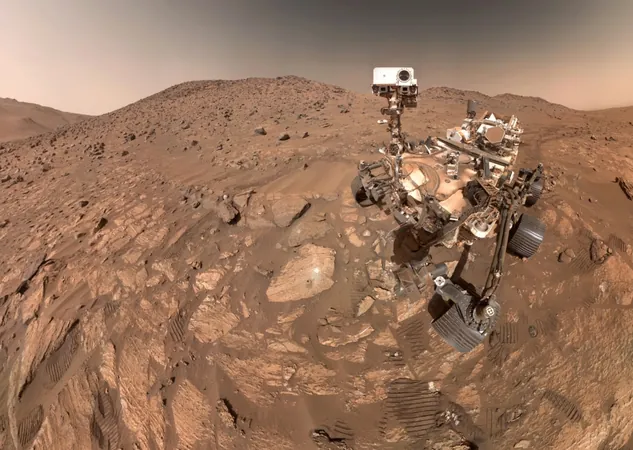
NASA's Perseverance Rover Makes Groundbreaking Discovery on Mars
2025-09-21
Author: Daniel
Life Beyond Earth? A Revelation from Mars!
In a thrilling twist in the quest for extraterrestrial life, NASA's Perseverance rover has unearthed compelling evidence that could hint at ancient microbial life on Mars. Scientists revealed that a rock sample, collected from the Cheyava Falls outcrop and dubbed Sapphire Canyon, may bear chemical signatures of life, making this discovery one of the closest humanity has come to proving we are not alone in the universe.
Hidden Treasures in Jezero Crater's River Valley
Discovered in July 2024 during its exploration of the Bright Angel formation, Cheyava Falls is situated in a region that once funneled water into Jezero Crater—a site believed to have harbored a vast ancient lake. The sedimentary rocks here, laden with clay, silt, and organic carbon, offer promising conditions for preserving microbial remnants.
These rocks are also rich in sulfur, oxidized iron, and phosphorus—elements crucial for primitive life. This suggests that Mars may have been a habitable environment far longer than previously thought.
Intriguing Patterns Discovered in Martian Mudstone
Upon closer inspection using high-resolution instruments, the rover detected striking "leopard spots"—mineral formations rich in vivianite and greigite, both of which have associations with organic materials on Earth. These patterns could signify energy-generating processes akin to those used by microbes.
Nevertheless, scientists caution that these minerals might form through geological processes, and there is no direct evidence linking them to life itself.
Rethinking Mars' Habitability Timeline
Cheyava Falls holds some of the youngest sedimentary rocks studied thus far, challenging previous assumptions that only older formations could reveal signs of ancient life. Joel Hurowitz, lead author of the recent Nature study, emphasized, "This is a potential fingerprint of microbial life, but we need further investigation to confirm any biological origins."
A Journey to Unraveling the Mystery
Since its landing in Jezero Crater in 2021, Perseverance has gathered 27 rock cores stored in metallic tubes, all poised for a future return to Earth. The intent behind this mission is clear: pinpoint potential signs of life and perform the ultimate analysis back home.
"We are pushing the rover to its limits. Now, the next big leap relies on bringing these samples back to our planet for in-depth examination," said Katie Stack Morgan, the project's lead scientist.
The Mars Sample Return Mission: Delays and Hopes
Initially set with a budget of $3 billion and a target re-entry by 2033, the Mars Sample Return mission's costs have skyrocketed to estimates between $6 and $11 billion, with a revised timeline potentially pushing the return date to the mid-2030s. Despite these challenges, NASA is fully invested in finding solutions to expedite the mission.
A Cosmic Question: Are We Alone?
The implications of the rover's findings are profound. Acting NASA Administrator Sean Duffy declared it a milestone in our journey to feel connected to the cosmos. "This is the closest we have ever come to discovering life on Mars," he noted.
Yet, as excitement builds, scientists remain vigilant. The intricacies of the leopard spots may represent Mars' most promising hint of life to date, but confirming their origins remains instrumental.
Perseverance's Ongoing Quest and What Lies Ahead
As Perseverance strides across Jezero Crater, each core sample it retrieves offers scientists invaluable insights into ancient life and the planet's climate—vital data for future human missions.
If the rocks from Sapphire Canyon indeed reveal biosignatures, they could represent humanity's first verified encounter with life beyond Earth—an extraordinary revelation that would shift our understanding of our place in the universe. Until the samples can be analyzed, they remain silent yet potent carriers of secrets from another world, waiting to unveil their mysteries.



 Brasil (PT)
Brasil (PT)
 Canada (EN)
Canada (EN)
 Chile (ES)
Chile (ES)
 Česko (CS)
Česko (CS)
 대한민국 (KO)
대한민국 (KO)
 España (ES)
España (ES)
 France (FR)
France (FR)
 Hong Kong (EN)
Hong Kong (EN)
 Italia (IT)
Italia (IT)
 日本 (JA)
日本 (JA)
 Magyarország (HU)
Magyarország (HU)
 Norge (NO)
Norge (NO)
 Polska (PL)
Polska (PL)
 Schweiz (DE)
Schweiz (DE)
 Singapore (EN)
Singapore (EN)
 Sverige (SV)
Sverige (SV)
 Suomi (FI)
Suomi (FI)
 Türkiye (TR)
Türkiye (TR)
 الإمارات العربية المتحدة (AR)
الإمارات العربية المتحدة (AR)